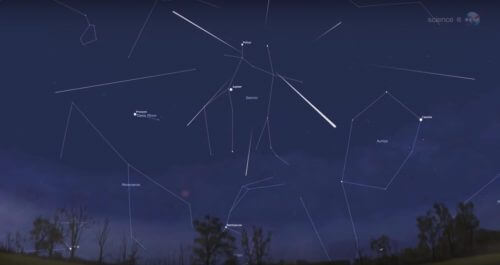They will be best seen between 19:30 local time on December 13 and sunrise on the morning of December 14, with most meteors visible between midnight and 4 am on December 14.

You may have seen a bright streak left behind by a meteor in the December sky? This is a sign that the Geminid meteor shower has arrived. And all astronomy enthusiasts should wear warm clothes and go outside, away from the cities.
The Israeli Astronomical Society has developed an application that will make it possible to count the meteors with greater precision than by manual recording.
"The Perseid shower of August will be hidden by the bright moonlight. The Geminids will be the best meteor this year," says Bill Cook, a NASA meteor expert. "Now however, the thin crescent and the waning moon will not ruin the meteor show." Cook added.
The shower will reach its peak on the night of December 13-14 with a meteor visible in a minute, in good visibility conditions. According to Cook, Geminids can be seen on the nights before and after the Dec. 14 peak, although they will appear less frequently. The best time to view them will be between 19:30 p.m. local time on December 13 and sunrise on the morning of December 14, with most meteors visible between midnight and 4 a.m. on December 14.
The origin of the shower is from dust particles ejected from the near-Earth asteroid (or perhaps a 'dead' comet). Pathon during its orbit around the sun. Once a year the Earth passes through the trail, and when these particles enter the atmosphere they cause the ionization of the gases in our atmosphere. This ionization causes the flashes of light that we see.
As an added bonus this year, astronomers will have a chance to study Phaethon up close in mid-December, when it will pass at its closest point to Earth since its discovery in 1983.
Meteors are named for the location from which they are seen emerging, usually a star or constellation. This meter comes from the direction of a group of twins. Because this is a relatively northern group, observers in the southern hemisphere will see only a few meteors.
The Israeli Astronomical Society stated that in Israel a double rate is expected during the peak time, of about 120 meteors per hour. Since at the latitude of Israel the radiant (the point in the sky from which the meteors are seen emerging) passes early in the morning very close to the zenith (the point above the head), the actual rate is expected to be similar to the forecast.
In order to view the meteor, it is recommended to go to dark areas in the south of the country, because the light pollution emanating from the settlements dazzles us and causes us to be able to see only the brightest meteors. Therefore, there will be no activity at the observatory in Givatayim. There is no need for any optical means - all you need is to lie on your back and watch the sky in all its glory.
Application for recording meteors
Members of the association's meteor division, led by Anna Levin, will record the meteor throughout the week. This time, in addition to the traditional manual registration, they will also hold an electronic registration for the first time using a new application developed by Hanan Dan and which is currently being run. The goals of the application are to prevent errors that occur when manually recording in total darkness (such as double writing on the same place on the page) and to facilitate data processing. If you also plan to travel to the south, watch the meter. To download the application and experience the meter documentation (for now only for Android). The data that the members of the Meteor Division will collect along the meter will be sent to the International Meteor Organization (IMO) and will be used for research on the dust trails through which the Earth passes.
Some of the materials are taken fromThe Facebook page of the Israeli Astronomy Association.
and another part - From the NASA website
